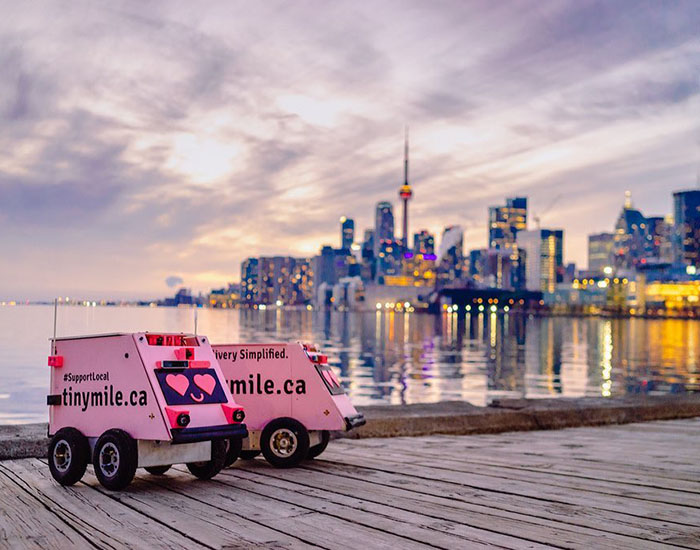|
Listen to this article  |

Tiny Mile’s delivery robots will pause operations in Toronto while the City Council decides on whether or not to approve the ban. | Photo Credit: Tiny Mile
The Toronto City Council is considering banning mobile robots from sidewalks and bike paths.
The provision was originally put forward by the Toronto Accessibility Advisory Committee. The committee voiced concerns about sidewalk robots being hazards for people with low mobility or vision as well as elderly people and children.
If passed, the provision would ban all robots that operate on anything other than muscular power, are automated or remote controlled and don’t transport passengers. Those who violate the provision would face a $150 fine.
Last week, the Infrastructure and Environment Committee approved the provision. Next week, on December 15, the City Council will vote on whether or not to put it into effect.
Already, robotics companies are responding to the possible change. Tiny Mile, a company operating delivery robots in Toronto, announced on its Instagram today that it has decided to temporarily remove its robots from the city.
“Whether it’s providing a service to improve the lives of people with disabilities or reducing emissions from the delivery service industry, we believe our technology has a role to play in the Toronto of tomorrow,” the company said. “That’s why, in the spirit of good faith and the desire to get it right, we will temporarily take all our robots off the streets, to have time to collaborate with authorities and the accessibility community to showcase all the safety mechanisms we have put in place and get feedback on product improvements.”
Tiny Mile’s small, pink delivery robots, named Geoffrey, began delivering in Toronto in September 2020. The robots aren’t autonomous, but are remotely controlled by human operators miles away.
Cities push back on robotics
The ban comes in response to a 10-year pilot provision. The provision would have allowed robots to operate on sidewalks, with some stipulations. Robots could not go any faster than 10 km/hr and be marked with the operator’s name and contact details. The robots would also be required to have audible signals, reflectors with lights, brakes, insurance and must yield to pedestrians.
“This pilot would be yet another dangerous hazard in the public realm for anyone with low mobility, low vision, or using a mobility device as well as children and senior residents,” said Councillor Kristyn Wong-Tam, in her letter recommending the ban to the City Council.
The Toronto City Council isn’t the first governing body to consider limitations on delivery robots. In December 2017, San Francisco voted to ban delivery robots on most sidewalks, and greatly restrict use in permitted areas. The ban prevented robotics companies from operating sidewalk delivery robots in San Francisco until 2019, when Postmates was approved for the first permit to test sidewalk deliveries in the city.
Earlier this month, the San Francisco Municipal Transportation Agency (SFMTA) challenged Cruise’s application to deploy its autonomous robotaxis in San Francisco.
Cruise’s robotaxis were given the OK for giving public rides from the California DMV in October, and Cruise’s first driverless taxi was hailed in November. However, the SFMTA claimed that Cruise’s taxis have been illegally double parking during testing.
The California Public Utilities Commission will ultimately decide whether or not Cruise can begin charging for public rides.
Other cities and states have taken a different approach to sidewalk robots. In 2017, Virginia became the first state to legalize sidewalk robots. In 2020, the state updated its laws to allow heavier robots to operate on sidewalks and roads, if there is no sidewalk available. The robots can go up to 10 mph on the sidewalk and 25 mph on roads.
The state of Pennsylvania legalized sidewalk robots in November 2020. Under the state’s law sidewalk robots are considered pedestrians, and can travel up to 12 mph. So far, 21 states have legalized sidewalk robots in some form.
Credit: Source link


Comments are closed.